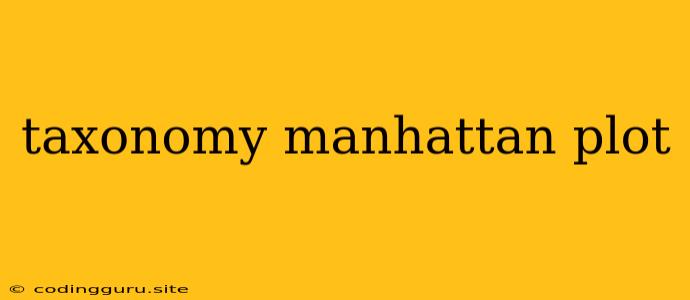Understanding the Power of a Manhattan Plot in Taxonomy
Have you ever looked at a vast dataset of taxonomic information and felt overwhelmed? Trying to identify the key players in a complex microbiome, or discern the subtle shifts in species composition across different environments, can be a daunting task. This is where Manhattan plots come into play, offering a powerful visual tool to explore and interpret taxonomic data.
What is a Manhattan Plot?
Imagine a cityscape where skyscrapers represent significant differences in taxonomic abundance. This is essentially what a Manhattan plot does: it plots the statistical significance of each taxonomic feature against its position on the genome (or taxonomic hierarchy). The result is a visually striking display where tall peaks represent taxonomic groups that are significantly different from the background.
Why Use a Manhattan Plot for Taxonomy?
- Visual Clarity: A Manhattan plot provides a clear overview of the most significant taxonomic features, allowing you to identify outliers and potential drivers of microbiome variation.
- Easy Interpretation: Even without extensive statistical expertise, the visual representation helps researchers quickly understand the main findings of a taxonomic analysis.
- Statistical Significance: The plot indicates the statistical significance of each taxonomic feature, ensuring that the findings are robust and reliable.
Building a Manhattan Plot for Your Taxonomic Data
Creating a Manhattan plot typically involves these steps:
- Data Preparation: Start with your taxonomic data, often in a format like a table with taxonomic classifications and abundance values.
- Statistical Analysis: Perform a statistical test (e.g., ANOVA, t-test) to assess the significance of differences in taxonomic abundance between groups or conditions.
- Data Transformation: Transform the statistical test results into a format suitable for plotting. This often involves calculating p-values and adjusting for multiple comparisons.
- Visualization: Use a plotting library (e.g., ggplot2 in R, matplotlib in Python) to create the Manhattan plot.
Interpreting the Manhattan Plot
Manhattan plots provide insights into the following aspects of your taxonomic data:
- Significant Taxa: The tallest peaks identify the taxonomic features with the strongest association to the variable of interest.
- Taxonomic Trends: By observing the distribution of peaks, you can identify clusters of related taxa that are consistently changing across different conditions.
- Potential Drivers: Significant taxa identified by the Manhattan plot provide clues about the potential biological or environmental factors driving the observed microbiome shifts.
Example: Exploring Microbiome Variation in Soil
Imagine a study investigating the impact of agricultural practices on soil microbiome composition. A Manhattan plot could visually represent the key taxa associated with different agricultural techniques (e.g., organic vs. conventional farming). The plot might reveal that certain bacterial genera are significantly enriched in organic soils, while others are more abundant in conventionally managed fields. This information could lead to further investigation into the ecological roles of these taxa and their potential contribution to soil health.
Tips for Creating Effective Manhattan Plots
- Choose an Appropriate Statistical Test: Select a test suitable for the type of data and research question (e.g., paired t-test for comparing two groups, ANOVA for multiple groups).
- Apply Multiple Comparison Adjustment: Correct for multiple comparisons to avoid false positives, as many taxonomic features are being tested simultaneously.
- Clear Axis Labels: Use informative labels on the x-axis (e.g., taxonomic classification, gene location) and y-axis (e.g., p-value, adjusted p-value).
- Color Coding: Employ color coding to highlight specific taxonomic groups or features of interest.
Conclusion
Manhattan plots are a powerful tool for visualizing and interpreting taxonomic data, providing a clear and intuitive representation of significant differences in microbial abundance. By understanding the principles behind these plots and employing best practices for their creation, researchers can gain valuable insights into the structure and function of complex microbiomes, ultimately contributing to advancements in fields like medicine, agriculture, and environmental science.
